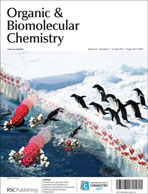Researchers from the University of Alberta, Canada, have discovered an antagonist with impressive nanomolar inhibition of cholera toxin (CT) using a novel approach to design and synthesise a small, focused library of CT binding ligands.
David Bundle and co-workers aimed to design a ligand capable of binding to cholera toxin and that could be orally administered. CT is the most important virulence factor in the disease and deactivating bacterial toxins may reduce the development of antibiotic resistance – a real problem in current cholera treatments. Binding to CT occurs predominantly at GM1 receptor, and a multiple binding strategy through weak ligand interactions has been demonstrated to be very effective.
Here, the authors have created a compound library of heterobifunctional ligands, with an invariable ligand, galactose – which is very effective at binding to GM1 – conjugated to a polymer carrier. The other, non-galactose ligand fragment was varied to probe a complimentary GM1 binding site. The polymer scaffold, polyacrylamide or dextran, provided a framework for the synthesis, purification and assay of the compounds as well as being necessary for the multivalent presentation of the ligands. The library allowed the authors to identify weak ligands that are capable of complimenting the binding affinity of galactose for the cholera toxin protein.
Read how the authors obtained the nanomolar inhibition activities here – the article is free to access for four weeks!
Multifunctional multivalency: a focused library of polymeric cholera toxin antagonists
Huu-Anh Tran, Pavel I. Kitov, Eugenia Paszkiewicz, Joanna M. Sadowska and David R. Bundle
Org. Biomol. Chem., 2011, Advance Article
DOI: 10.1039/C0OB01089H











 Atsushi Ikeda and colleagues describe in this paper, which is the outside cover of
Atsushi Ikeda and colleagues describe in this paper, which is the outside cover of